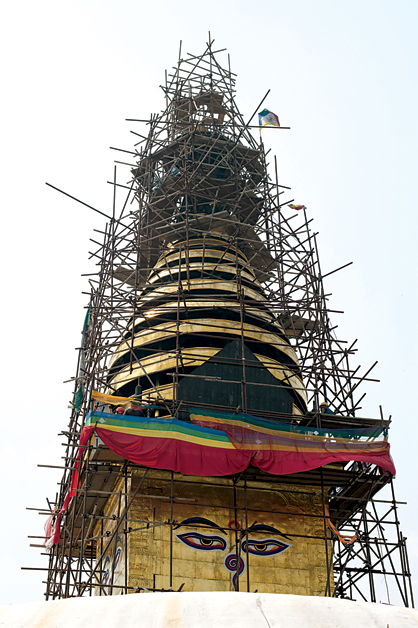Visitors to the iconic hilltop Buddhist temple of Swayambhunath will soon discover that all that glitters is indeed gold. The gilded spire of the temple, visible from lower lying areas of the valley, has been encased in scaffolding for the last two years as workers were engaged in replacing the gold plating and carrying out various other restoration works.
Despite the general maintenance undertaken by the Federation of the Swayambhu Management and Conservation Office (FSMC), the last major restoration work dates back to the early 20th century.
 “The original gold plating was added 107 years ago, so some of the gold and copper plates have been damaged,” explained Mr. Mahendra Ratna Shakya, General Secretary of the FSMC.
“The original gold plating was added 107 years ago, so some of the gold and copper plates have been damaged,” explained Mr. Mahendra Ratna Shakya, General Secretary of the FSMC.
This massive undertaking is sponsored by the Tibetan Nyingma Meditation Centre, a Buddhist institute based in Berkeley, California. The institute’s focus on preservation of Buddhist culture led to an interest in the physical state of Swayambhunath. In 2008, members of the Meditation Centre visited the FSMC with an offer to sponsor restoration works at the temple.
“Nepal’s Archaeology Department visited the temple first to check for damages before approving the works. On 23 July, 2008, we officially began restoration works, and the FSMC acts as a middleman between the
Meditation Centre and Nepal’s Archaeology Department,” said Mr. Mahendra.
Restoration works are nearly complete, according to Mr. Gyanu Lama, Vice President of the FSMC.
“The top of the spire is expected to be fully completed by the end of April, and worshippers coming here say it looks really nice,” he said.
The aesthetic overhaul of the temple, said to be about 1,500 years old, comes with a hefty price tag of a little over 46 million rupees. The main bulk of the work—deciding where to place about 17 kg of pure gold—was entrusted to a local expert Lok Ratna Shakya. Unfortunately, he passed away three months ago, and his wife has carried on the task.
Other than the Mahachaitya spire, restorative works were also done on nine surrounding temple shrines, the Buddha and Tara shrines, the large Vajra on the east entrance and several other artifacts with damaged gold plates.
The current set of gold plates is expected to last a hundred years, and has been worked on almost daily by a group of about 30 workers.
“All our staff are Nepali, doing different jobs like carpentry, copper-metal works, stone carvings, and, of course, the gold plating,” said Mr. Mahendra.
In keeping with Tibetan-Buddhist traditions, a priest is on hand to conduct a puja at every point of the renovations. According to the official budget set by the Meditation Centre, nearly half of the 3.5 million rupees set aside for administrative costs went to these pujas, with the rest going to staff salaries and security personnel.
Mr. Mahendra said: “There will be a big inauguration ceremony once the restoration is finally completed.”
The spire now has a dazzling golden sheen and sparkles in the afternoon sun when seen from a distance—a fitting look for one of Nepal’s must-visit locations.











